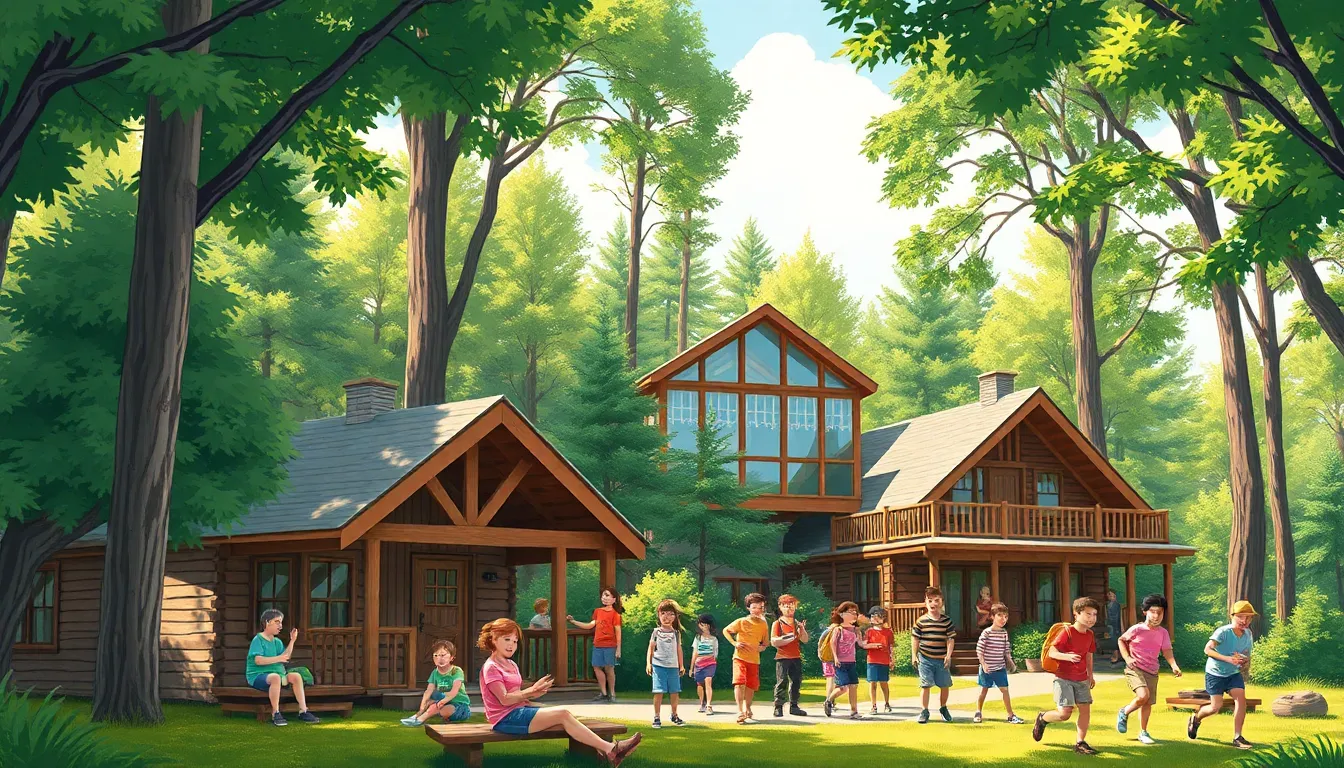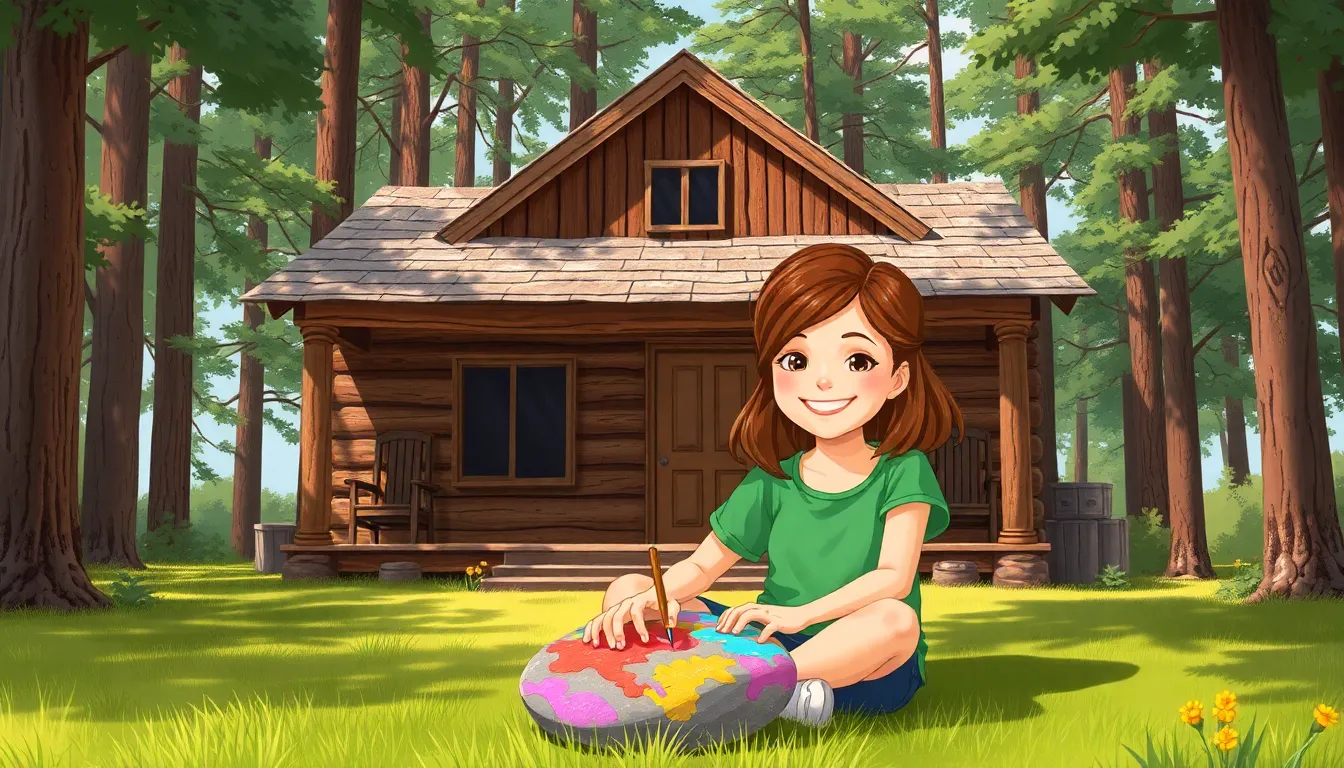When summer rolls around, visions of s’mores and starry nights dance in everyone’s heads. But nothing quite captures the essence of camp like the cozy charm of summer camp cabins. These rustic retreats are more than just four walls and a roof; they’re the perfect backdrop for adventure, friendship, and maybe a few ghost stories that’ll keep campers up all night.
Imagine waking up to the sound of chirping birds and the smell of pine trees. With a cabin as your home base, every day is an opportunity for new experiences—whether it’s canoeing on a shimmering lake or crafting the ultimate friendship bracelet. So, grab your bug spray and get ready to discover why these cabins aren’t just a place to sleep; they’re where memories are made, laughter echoes, and summer dreams come alive.
Table of Contents
ToggleOverview Of Summer Camp Cabins
Summer camp cabins provide a unique space for camaraderie and adventure. These structures often feature rustic designs, creating an inviting atmosphere that complements the natural surroundings. Many cabins range in size, accommodating small groups or larger gatherings. Inside, campers find essentials like bunk beds, a common area, and sometimes even amenities such as electricity and running water.
Campers engage in various activities within these cabins. Arts and crafts projects often take place in communal spaces, encouraging creativity and teamwork. Evening storytelling sessions around a cozy campfire usually foster bonds among campers, creating memories that last a lifetime.
Nature plays a significant role in the overall experience. The sounds of rustling leaves and chirping birds often provide a soothing backdrop, enhancing relaxation and connection with the outdoors. Fresh air fills the cabin spaces, inspiring campers to embrace outdoor adventures like canoeing, hiking, and swimming in nearby lakes.
Some summer camp cabins offer a more immersive experience, allowing campers to disconnect from technology. Without distractions, they focus on building friendships and exploring the wilderness. Overall, these cabins serve as a vital hub for activities, learning, and growth during the summer camp experience.
Types Of Summer Camp Cabins

Summer camp cabins come in various styles, each offering unique experiences. Understanding these options enhances the overall camp adventure.
Traditional Cabins
Traditional cabins embody rustic charm, featuring classic wooden structures. Built with simplicity in mind, these cabins often include bunk beds and communal spaces for gathering. Campers find comfort in their cozy atmosphere, creating an intimate environment for friendships to blossom. Many traditional cabins lack modern amenities, enhancing the immersive experience of nature. Campers appreciate the nostalgia such cabins evoke, connecting them with childhood memories of outdoor adventures and storytelling by the fire.
Modern Cabins
Modern cabins provide a contemporary twist on the summer camp experience. Equipped with essential amenities, these cabins often include en-suite bathrooms and climate control, catering to comfort. Campers enjoy spacious layouts featuring upgraded furnishings and technology. Many modern cabins maintain a connection to nature through large windows and outdoor decks. These designs encourage an appreciation for the surroundings while offering a more luxurious experience. Campers value the blend of comfort and adventure found in modern cabins, making them a popular choice among families.
Features Of Summer Camp Cabins
Summer camp cabins offer unique features that create memorable experiences for campers. Each aspect of these cabins is designed to enhance comfort and foster community.
Sleeping Arrangements
Sleeping arrangements cater to various group sizes. Bunk beds often line the walls, promoting a cozy environment for campers. For larger groups, cabins have additional sleeping spaces or mattresses that maximize occupancy. Some cabins also include lofted beds, adding an element of fun and maximizing floor space. Emphasizing comfort, bedding typically consists of foam mattresses or soft sleeping bags, ensuring restful nights. Campers share sleeping quarters, which encourages friendships and bonding.
Common Areas
Common areas serve as the heart of the cabin environment. These spaces foster interaction and collaboration. Often, a communal seating arrangement provides comfort for gatherings, storytelling, or games. In addition, some cabins feature a central fireplace or wood stove, enhancing warmth and atmosphere during cooler evenings. Campers enjoy crafting, movie nights, or simply relaxing in these shared areas, making lasting memories. Windows offer views of nature, allowing natural light to brighten the surroundings.
Amenities
Amenities often reflect the blend of rustic charm and modern convenience. Many cabins include electricity for lighting and charging devices, retaining a connection to the outside world while promoting nature immersion. Basic kitchen facilities or communal dining spaces typically facilitate meal preparation and socialization. Additionally, restrooms are commonly located within or near cabins, enhancing comfort during late-night hours. Outdoor fire pits provide opportunities for cooking s’mores and sharing stories under the stars, further enriching the camp experience.
Benefits Of Staying In Summer Camp Cabins
Staying in summer camp cabins offers numerous advantages that enhance the overall camp experience. Connection to nature stands out as a primary benefit, allowing campers to immerse themselves in the outdoor environment. Campers often enjoy the tranquility of their surroundings, leading to improved mental well-being.
Comfort and safety come into play with the sturdy structures of these cabins. Each cabin typically features secure doors and windows, providing a safe space for children during their adventures. Different cabin styles cater to various preferences, ensuring that every camper finds their ideal setting.
Social interaction thrives in this communal atmosphere. Shared living spaces encourage collaboration and bonding among campers, creating lasting friendships. Organizing group activities and experiences around a central area fosters teamwork and teamwork skills.
A feeling of nostalgia often arises from the rustic charm of traditional cabins. Elements such as wooden beams and campfire storytelling bring the camp experience to life. Memories made in these cabins tend to stick with campers long after they leave.
Amenities provided by both traditional and modern cabins enhance comfort without sacrificing the camping experience. Features like electricity, basic kitchens, and fire pits make life easier for campers. Outdoor decks offer spaces to relax while enjoying nature and connecting with fellow campers.
Accessibility stands as another key benefit, with cabins designed to accommodate various group sizes. Flexible layouts ensure families or larger scout groups can comfortably stay together. This arrangement can lead to a deeper appreciation for shared moments during summer camp.
Overall, embracing the experience of staying in summer camp cabins enriches both personal growth and communal bonds, making it unforgettable.
Tips For Choosing The Right Summer Camp Cabin
Selecting the ideal summer camp cabin involves several factors to enhance the experience. Consider the cabin size, as it needs to accommodate the group comfortably. Evaluate sleeping arrangements, opting for bunk beds or lofted beds that encourage interaction among campers. Assess the amenities provided, with options ranging from basic facilities to modern conveniences like electricity and kitchen space.
Prioritize location, ensuring the cabin is near common areas or activity sites to maximize participation in campsites. Look for safety features, including proper escape routes and sturdy structures that provide peace of mind. Understand the level of privacy required; some cabins offer shared spaces, promoting bonding, while others provide more secluded options.
Review accessibility features, ensuring the cabin meets the needs of all campers. Determine if it has ramps or spacious common areas for ease of movement. Consider the communal atmosphere, as cabins with shared fire pits or gathering spots create opportunities for storytelling and socializing.
Inspect the cabin’s design, which can range from rustic charm to modern style. A traditional cabin may evoke nostalgia, while a contemporary option might appeal to families seeking comfort. Keep in mind the connection to nature, noticing how large windows or outdoor decks can enhance the experience.
Finally, weigh the camp’s overall vibe. A cabin nestled in a serene forest setting might draw some, while others prefer proximity to water activities. Making informed choices leads to memorable summer camp experiences, ensuring both comfort and adventure are part of the journey.
Summer camp cabins stand as the heart of unforgettable experiences. They offer a unique blend of charm and comfort that fosters connections among campers. Whether nestled in nature or equipped with modern amenities, these cabins create an inviting atmosphere for adventure and camaraderie.
The memories made within their walls—through storytelling, crafts, and shared meals—become cherished moments that last a lifetime. As campers disconnect from the digital world and embrace the great outdoors, the bonds they form in these cabins enrich their lives in ways that extend far beyond summer.
Choosing the right cabin can enhance this experience, ensuring that each camper finds their perfect retreat. Ultimately, summer camp cabins are more than just a place to sleep; they’re a foundation for growth, friendship, and adventure.




